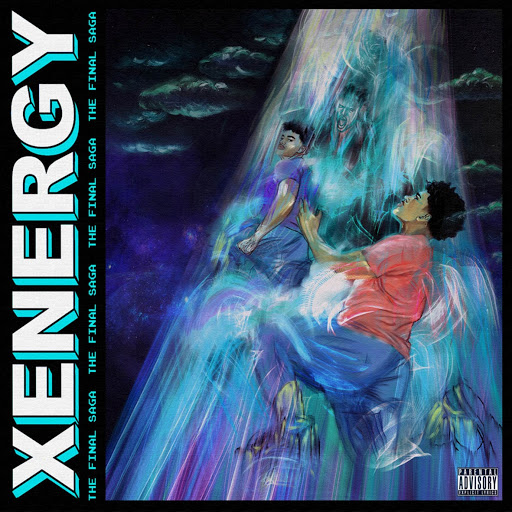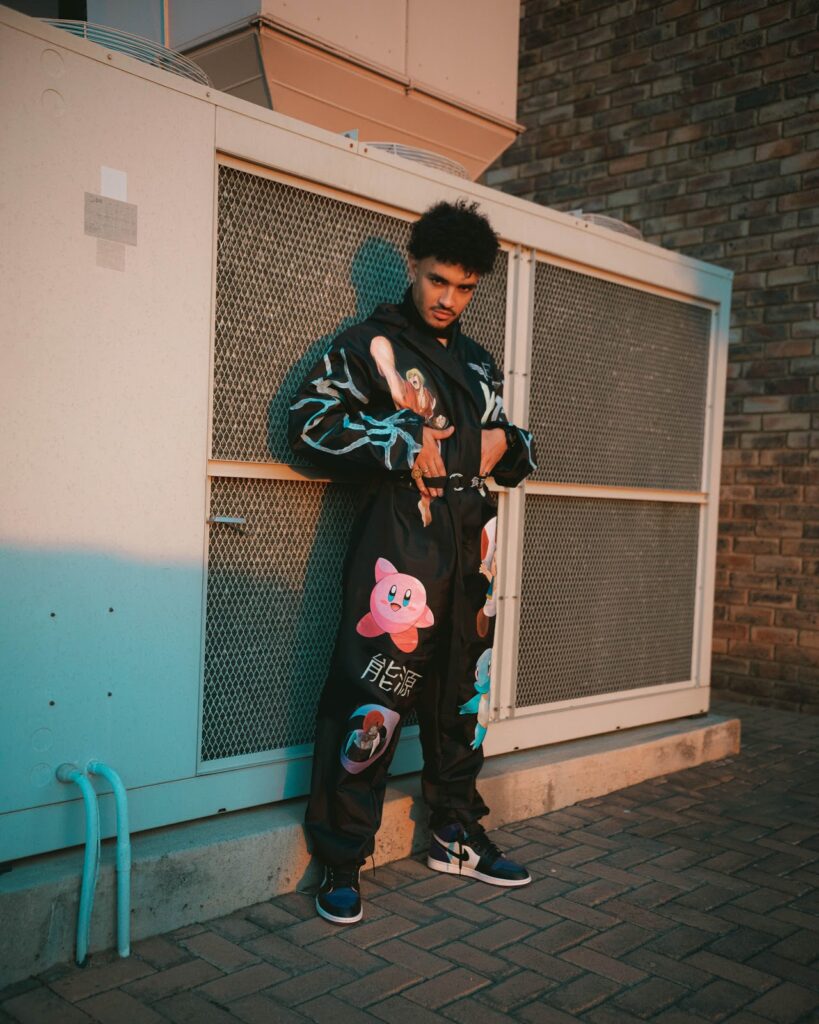In his new visual album, Shane Eagle portrays himself as a heroic character in a fictitious universe, which is the basis of rap music. (Photo: Kgotso Aphane/Maverick Seizure)
Were it not for the ongoing Covid-19 pandemic, Shane Eagle would be on the road touring for his 2019 mixtape Dark Moon Flwr. Instead Xenergy: The Final Saga Visual Album, his new album, serves as the Ruby Ridge-born rapper’s virtual tour.
Just as he would if he were performing at venues, for the visual album, Shane Eagle picked fan favourites from Dark Moon Flwr, alongside personal favourites, and rendered them on stage.
Clear mind and pure soul
Shane Eagle performs songs such as Zaire, Storytime, Up 1, June and a few others amid a virtual cosmological world called Xenergy. “Xenergy”, according to the South African Music Award-winning lyricist, is another term for “energy”.
“It is a term I like to use to describe the balance of a clear mind and pure soul,” says Shane Eagle in the project’s press release.
This clear mind and pure soul are unpacked in the songs he chooses — a majority of them consist of calming lo-fi production and introspective lyrics that reveal a relatable young man who is at peace with himself after building a successful career as an honest and sentimental lyricist. Artists, especially rappers, of that school of thought rarely get mainstream recognition.
As the director of Xenergy, Shane Eagle manages to create a unitary series of environments that speak to his monolithic sound as a musician. These being essentially live performances, he ensures minimal distraction from him and the music by using animations and visual effects sparingly.
 In Xenergy, Shane Eagle manages to create a unitary series of environments that speak to his monolithic sound as a musician.
In Xenergy, Shane Eagle manages to create a unitary series of environments that speak to his monolithic sound as a musician.
To bring his vision to life, he deploys the different skills of a team of artists including Nicole “Nikki” Swartz (the project’s executive producer, who also did creative and art direction), Tebogo “GraphixGuy” Laka (co-director and visual effects editor), Imraan Christian (assistant director), Stage Tech & Dave Sampson Solutions (live sound engineering) and a few others.
Xenergy: The Final Saga is a hypnotic series of minimalist visual pieces that will find viewers domiciled in a world where only Shane and his story exist.
Into the YellowVerse
His previous visual project, 2018’s YellowVerse, was designed to be a visual narrative rather than a virtual concert.
It showed Shane Eagle roaming various worlds inhabited by him and his girlfriend Nikki, with a few creatures making an appearance. Before the release of the album, Shane Eagle hosted an exhibition of portraits of him in the YellowVerse in Braamfontein just before embarking on the countrywide Yellow Tour in 2018.
Part of Shane Eagle’s brief to Nkululeko “Armsdeal” Lebambo who directed the YellowVerse short film was, “I want to do something that has to do with me and my world, my universe.’” While performing a selection of songs from his debut album, Yellow, Shane Eagle travels between different planets in the YellowVerse.
Yellow is the colour in which Shane Eagle thinks, he revealed in a 2017 interview just after the release of his debut album.
 Shane Eagle has chosen songs from his 2019 album, Dark Moon Flwr, and presented them visually in Xenergy: The Final Saga. (Photo: Kgotso Aphane/Maverick Seizure)
Shane Eagle has chosen songs from his 2019 album, Dark Moon Flwr, and presented them visually in Xenergy: The Final Saga. (Photo: Kgotso Aphane/Maverick Seizure)
In Xenergy: The Final Saga, the concept is fundamentally the same — Shane Eagle takes the viewer into his own world for its 19-minute duration.
He belts out raps that meander between vulnerable and egocentric. He raps about his late father, spirituality, love and the art world. The visual’s aesthetic fits Shane Eagle’s lo-fi-leaning production and his introspective rhymes.
Childhood fantasies
The visuals are inspired by Shane Eagle’s obsession with the cosmos and the endless nature of space. Cartoons and video games inform his art direction. In his growing discography, he has shown an appreciation for the medium; this always adds a youthful dimension to his music, which can get heavy thematically. Just like Wu-Tang Clan and other artists they influenced before him, Shane Eagle manages to marry the worlds of rap and fantasy seamlessly. He portrays himself as a heroic character in a fictitious universe, which is the basis of rap music. His videos always combine high art, animations and hip-hop aesthetics.
As video becomes one of the most popular mediums online, musicians are pivoting with everyone and releasing more than just music videos. Visual albums, though not new (they date back to the 1960s), made a huge comeback in the 2010s as artists embraced slashie culture by exploring different media forms.
Kanye West’s Runaway film, which was released before his 2010 album My Beautiful Dark Twisted Fantasy, tells an ambiguously layered story while music from the album plays. Runaway laid the blueprint for modern visual albums. Beyoncé’s self-titled visual album, released three years later, was essentially just a series of music videos. But her second attempt at the medium on Lemonade (2016) was more refined, telling one story that lasts for a whole hour, much like Runaway. A few months after the release of Lemonade, Frank Ocean released his own visual album, titled Endless.
 Earlier this year, Apple Music released the mini doccie Rap Life: Ebro in South Africa, which saw Darden spending time with and getting to know three of his favourite SA hip-hop artists, among them, Shane Eagle. (Photo: Kgotso Aphane/Maverick Seizure)
Earlier this year, Apple Music released the mini doccie Rap Life: Ebro in South Africa, which saw Darden spending time with and getting to know three of his favourite SA hip-hop artists, among them, Shane Eagle. (Photo: Kgotso Aphane/Maverick Seizure)
A visual album isn’t for every artist — not every musician has the talent and vision to pull it off. So far, the medium has been attempted by audacious artists, most of whom have big cult followings such as those mentioned above. In South Africa, the rapper Tumi Molekane (now known as Stogie T) and the French production trio Chinese Man released a 24-minute music video for their 2016 collaborative EP, titled The Journey. The clip shows the rapper performing the songs in Paris, walking from one set to another.
Torchbearer
Shane Eagle is one of the few South African artists who seem to be fixated on the idea of the visual album. It’s probably based on the success of YellowVerse. The 15-minute audio-visual experience has more than 185 000 views on YouTube — a reasonably large number by South African standards, and one that’s impressive for a niche hip-hop artist such as Shane Eagle.
And it goes against the grain that has brought him this far. From releasing his projects without major lead singles, to sticking to his own lo-fi leaning sound and personal lyrics, while attracting high-profile international collaborators (Bas, The Hics and Kota The Friend among them), the independent rapper answers to no one but himself and always plays the game by his own rules.
Xenergy is just a virtual concert, but it still sets the rapper apart from his counterparts. Most artists opted for virtual performances during the country’s lockdown, but not many of them ensured a curated experience using multiple mediums to take advantage of the control virtual shows offer artists.
Visuals play a huge role in the internet era. Apart from being a visual interpretation of the music, they manage to give songs an extended life, which is crucial at a time when fans have short attention spans,and, owing to the abundance of releases, move on too quickly from a body of work.
Maybe Xenergy didn’t break the internet or lead to a slew of opinion pieces the way Lemonade did, but it does lay the foundation for visual albums in South African hip-hop. South Africa has a tendency to take its time to warm up to new ideas. Against this backdrop, Shane Eagle is a torchbearer and his visual releases might get cited in future if more artists hop onto the trend.
Xenergy was released exclusively on Apple Music.